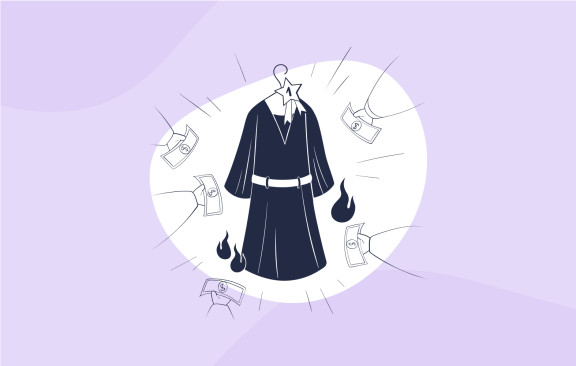Starting an online business is an exciting journey, but you’re bound to run into challenges along the way. One of the first obstacles new entrepreneurs face is how to choose the right product to sell online. This decision is essential to the success of your business, but with millions of options for products and suppliers and fierce competition from other sellers, where do you start?
If you’ve gotten this far in your ecommerce journey, you’ve probably read the success stories of sellers who are making five-, six- or seven-figure incomes from selling products online. But how do top sellers find hot products, do market research, and source suppliers to turn their business dreams into reality?
Big retail companies have entire departments dedicated to selecting, validating and sourcing products. However, most online sellers start out by doing everything themselves.
It can seem daunting, but the process of choosing a great product doesn’t have to be scary or overwhelming. With the help of some great online tools and basic business acumen, choosing the right product is relatively simple. You just need to put in a bit of time and effort up front.
Finding a hot product (that's profitable!)
It can be easy to get caught up in finding the next big trend or the hottest product with the greatest profit margin. But many top sellers advise to take a step back at the beginning and reflect on your personal interests. The idea is that if you get into a market that you care about, it’s going to make doing business easier and more fun in the long run.
Maybe you’re passionate about health and fitness, dropshipping hair products, clothing, or electronics. Whatever it is, this is often a good place to start.
However, many top sellers ignore their interests entirely and rely heavily on market research and data to choose hot products.
Conducting market research
Once you have some idea of the market or niche you want to occupy, the first thing that every top seller should do is research. You can start by browsing online marketplaces such as eBay, Amazon and AliExpress to see what products are trending in your niche. These websites have bestseller lists that can help you hone in on popular products or markets.

Top sellers will also trawl social media platforms like Pinterest, Instagram, Polyvore and Fancy for inspiration.
Doing keyword research helps you dive a bit deeper into the viability of products.
Google Trends is a free tool that shows you how frequently words or terms have been searched for in a specified time period. This gives you an idea of whether the product is trending or on its way out. For example, if you were looking to sell a trendy tea product, you could compare interest in matcha powder and detox tea (see below).
If you have a Google AdWords account, you can also use Google’s Keyword Planner and our own Traffic Travis to do keyword research.
Product guidelines for best selling products
By now you might have a few ideas for products that you could sell, which is a great start. It’s advisable to run these ideas through a set of general product guidelines that top sellers use to narrow down their options. While these are not strict rules, they can help to make your products more attractive and minimize risk to you and your future customers.
- Is the product robust and easy to ship?
- Is the retail price within the “sweet spot” of $15–$200?
- Is it small and lightweight?
- Is it seasonal?
- Is it easy to source locally?
- Is it in a trending, stable or growing market?
The general guideline is that an ideal product for selling online should have few moving parts, be able to fit inside a shoe box, and sell for between $15 and $200 with a profit margin of at least 20–40% across all seasons. But there are always exceptions and profit margins of 100% or more are not uncommon.
There are also examples of seasonal products, such as Halloween costumes, being highly profitable for sellers, but you’ll want to have other products to keep things ticking over during the rest of the year.
Other important questions top sellers answer before choosing a product include:
- Who are your potential customers?
- What’s the potential size of your market?
- What are your potential sales and profit margins?
How to choose a product that will sell (and make you money!)
SaleHoo removes the guesswork from choosing a hot product with its market research tool, SaleHoo Labs. This gives sellers the power to research the sell rate, average price and competition for thousands of products across 27 categories.
- Sell-through rate
The sell rate is based on the number of successful listings compared with the number of total listings for a given product on eBay in the last month. - Average price
This is the average price that the product sold for on eBay during the previous month. - Competition
Competition is based on an analysis of the total number of sellers and listings for any given product. When you’re starting out it’s best to avoid highly competitive markets.
SaleHoo Labs uses data from eBay to determine the viability and profitability of products.

You can select a product type and browse through the options, altering the sell-through rate, average price and competition to find the perfect product.
How to use SaleHoo Labs
Let’s use the example of baby slings, a product that has been trending recently, to demonstrate how SaleHoo Labs works.
First select the “baby” product category, set the sell-through rate to at least 30%, and set an average price of between $0 and $60. We’ll select all competition levels to see what’s out there.

The search brings up two different types of baby sling—Boba Baby Wrap Grey and Sling Baby.
You can then select both products to compare them. This shows you their sell-through rates, current listings on eBay and average sale prices.

Based on this information, the Boba Baby Wrap Grey looks like the better option. With a sell-through rate of 70%, only 100 listings on eBay (compared to more than 30,000 for Sling Baby), and a higher average sale price, Boba Baby Wrap Grey has everything going for it.
You can then click on the product for information on suppliers, including whether they offer wholesale and dropshipping, where they’re located, minimum orders, and shipping and tax details.

There’s also the option to browse current listings of the product on eBay to see what the competition is up to.
You can click on a potential supplier to see a comprehensive overview of the company.
From there, you can contact suppliers directly to make an enquiry and get the ball rolling to either buy wholesale stock or set up your dropshipping business.
Finally, with SaleHoo Labs you can also save products you are interested in and search filters you want to return to. You can even set up email alerts for your saved searches.

Keeping an eye on product trends
SaleHoo Labs also provides information on trending products on eBay, updated every week. That makes it another helpful tool for choosing a hot product.
Just remember that as soon as a product starts trending, the market tends to become saturated as sellers jump on the latest craze. The idea is to think laterally and come up with alternative or complementary products that other sellers haven’t thought of yet.
Top seller tip #1: Upselling and Cross-selling
If you’re looking to get an edge on the competition, an insider tip is to consider upselling or cross-selling. Top sellers can increase their sales and profits considerably by using these sales methods.
Upselling
To use the classic fast-food example, upselling is asking if you’d like to “supersize” your meal. If we’re sticking with baby slings, that might be offering a customer the latest, best, most comfortable baby sling with a flower pattern at a higher price than the standard version.
To use a slightly different example, let’s just say you’re already selling the Fisher-Price Newborn Rock ‘n Play Sleeper pictured below.

While this might be a great product with an 82% sell-through rate at an average price of $71 on eBay, you could use SaleHoo Labs to find products to upsell to your customers.
For example, the Graco Pack ‘n Play Playard in the top right corner below has an average sale price of $200 and packs a whole lot more features than the more basic sleeper above. Or the Graco Simple Sway Swing is more affordable at $110.

Both of these potential upsells would earn you between $40-$130 more from the same customer that’s already prepared to buy from you.
Cross-selling
Cross-selling is asking “Would you like fries with that?” when a customer has just bought a burger. In the baby sling example, you already know that a customer is in the market for baby items so you could suggest that they also buy the matching baby booties or beanie to go with the sling for just a few dollars more. Or you might suggest they buy a baby toy or care product.
Using SaleHoo Labs you can simply run another search for baby products to find potential options for cross-selling.
Here we’ve set the sell rate to 30% with an average sale price of between $0-$100 and low to medium competition. This brings up several great products that might be of interest to a customer in the market for baby items.

Once you’ve found a product that you’re interested in cross-selling, just click on it to bring up more detailed information.
For example, this Piano Gym Kick and Play area for a baby, from trusted brand Fisher-Price, has a sell-through rate of 70% and only medium competition. It looks like the kind of thing new parents or grandparents might buy if they’re already buying a baby sling, especially when the average sale price is just $54.

You would then need to apply the same market research to this product to see if it is a viable cross-sell option for your business.
Upselling and cross-selling are generally easier than starting up an entirely new niche.
Related: Looking for the best baby products to sell online? Check out our article here!
Top seller tip #2: Private labelling
If you already have some experience selling online, then private labeling or creating your own brand is worth considering
Private labeling is placing your own brand or label on a product manufactured by a contract or third-party manufacturer. For example, you could arrange to have your own brand added to generic wooden sunglasses and sell them on your own website.
Searching for branded items in popular categories is a great way to come up with ideas for private label products.
You can also search for potential private label products using SaleHoo Labs.
Let’s try searching “Kitchen and Dining” for products with a 35% sell rate, up to $60, and low to medium competition.

Out of those options, the Totally Bamboo 3-Piece Cutting Board Set looks like it has potential for private labeling.
It’s a simple, trendy product that would be easy to add your personal brand to.
All you’d need to do is click on the product and contact the potential suppliers to see if private labeling is an option.
Some things to think about before deciding on a private label product are:
- Is a major brand currently dominating the market?
- Is the status quo product selling online?
- How can you add value to the product? (Branding, packaging, marketing)
Private labeling adds value to products and also allows you to experiment with developing your own brand. With lower Minimum Order Quantities from suppliers and manufacturers, and services like Fulfillment by Amazon, private labeling is becoming more accessible for online sellers.
Finding a supplier for your product
Once you’ve chosen a hot product to start selling online, you need to choose a reliable supplier from which to source that product. Using SaleHoo Labs, you can see a list of suppliers for any product with just one click.
SaleHoo provides information on more than 8,000 suppliers around the world, including how long they’ve been in business and how long they’ve been on SaleHoo, as well as their phone number, email, physical address and website. SaleHoo also includes basic company and product information for each supplier.
The best way to choose a supplier is to contact them directly and establish a relationship. Be friendly, be patient and be professional in your communications with suppliers to earn their respect and trust. Top sellers recommend contacting as many suppliers as possible to negotiate the best deal.
How to find trusted suppliers
So, you’ve chosen your hot product and have a list of potential suppliers. But how do you know a supplier is reliable?
To reduce the risk involved in ordering from a new supplier, you can start by ordering samples of your product to make sure it’s up to your standards. You can also test out their shipping by ordering a few products from them and seeing how long they take to arrive.
If the supplier is based in a country that speaks a language you know, try and get on the phone with a salesperson to establish rapport and clarify any issues. You can also ask them for a list of references.
SaleHoo vets all of the suppliers in its directory, which provides sellers with another layer of protection.
Here are a few things to establish before you commit to your first big order:
- Do they offer wholesale and dropshipping?
- What is the sample price?
- What is the product price?
- What is the minimum order quantity?
- What is their turnaround time for shipping?
- What do they have in their inventory?
- What hidden fees do they have?
Once you have a hot product and a reliable supplier, you’re ready to start selling online.










by clicking on the images never, I repeat NEVER, I found suppliers in the list that appears. They ALWAYS tell me they do not sell that product.